We frequently focus more on a house’s interiors, outside facades, and general design while designing it. Every house needs a roof, and the spotlight is typically on its functional advantages over its aesthetic appeal.
It may be a bit of a maze when it comes to choosing roof tiles design and how we want the exterior of our house to look because there are so many options. Here is a rundown of the most popular options of roof tiles design available in the market.
See also: Roof Design Ideas to Enhance your Beautiful Home in 2023
Best roof tiles design for your home
Red roof tiles design
It extends beyond the original structure, opening into a wonderful patio and giving the area a feeling of spaciousness and unity. The brickwork on the walls is congruent with the house’s brick exterior. The cream-coloured brick design on the exterior walls of the home is a fantastic match for the red roof tiles design. All of these minor details help it come together. It’s not just about choosing the cheapest tiles, but about putting a little extra thought into our selections can help us finish the project.
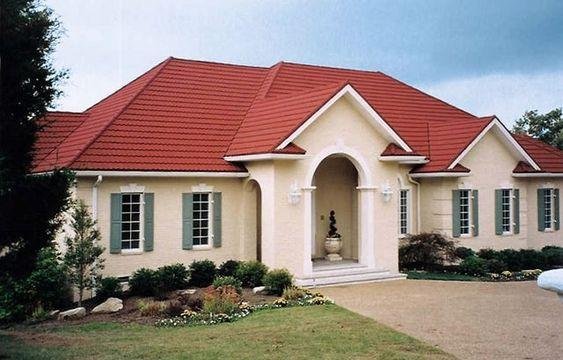
Source: Pinterest
Timber roof tiles design
In this picture, the exposed wood truly gives it a ranch-like vibe. The wood has a warm and inviting colour. The roof’s grey slate-coloured tiles stand out sharply against the building’s cream facade. The top of the roof is covered in a cosier red roof tiles design, which seamlessly complements the wood.

Source: Pinterest
Solar roof tiles
With solar roof tiles design, you may replace your conventional roofing material with electricity-generating roof tiles that connect to a rechargeable battery within your house and get their energy from the sun. A solar roof can drastically reduce your electric bill if there are enough tiles placed. There are a few various styles, but the majority of people are more concerned with how they perform than with how they seem. Solar roof tile designs are expensive and need specialised workers to install, maintain, and repair them.

Source: Pinterest
Slate roof tiles design
Slate is a natural stone with a distinct, lovely appearance. Slate has some striking colour variations that can only be created by nature and the passage of time. Slate is a resilient, long-lasting roofing material that also resists fire and fire-resistant roofing material. It might be among the most elegant roof tiles design available.
Slate’s disadvantage is that it weighs a tonne and needs to be supported by a stronger framework because of this. Repairs could be a concern because it is also challenging to handle and quite expensive to install.
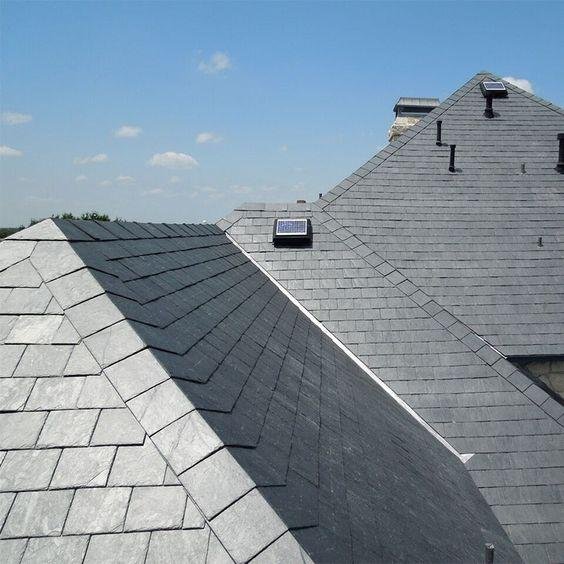
Source: Pinterest
Metal roof tiles design
Copper, aluminium, zinc, and steel are the materials that are most frequently used to make metal roof tiles. The most widely used of these materials are steel and aluminium. To replicate items like barrel tiles (Spanish roofs), slate tiles, wood shake tiles, and even standard shingle patterns, metal tiles are offered in a variety of designs and shapes. Due to their low weight and convenience of installation, metal roof tiles design have gained a lot of popularity, yet, these same advantages also pose some drawbacks.
.
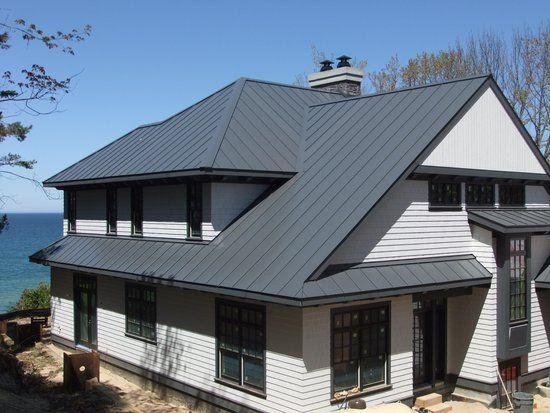
Source: Pinterest
Concrete roof tiles design
Concrete roof tiles design were initially created by hand, but as years moved by, modern production techniques allowed them to become one of the more affordable roof tile options available. Concrete tiles can be made to resemble wood shakes, clay tiles, and slate tiles, and they are quite beautiful.
Due to the weight of concrete, stone roofs require a strengthened roof framework to support the additional weight. Additionally, they require roofing teams who are knowledgeable about the equipment and methods needed to install concrete roof tiles correctly. They require a lot of the same upkeep as clay does.

Source: Pinterest
Clay roof tiles design
Clay has long been a widely available base material for tiles. The clay roof tiles design were shaped by hand, sun-dried and then used on the roof. Although the procedure is now largely automated, the final result is still stunning. The majority of us are accustomed to seeing clay roofs with flat or barrel-shaped tiles. They are sealed to prevent water absorption and are available in a range of colours.
Clay roof tiles design are very heavy, prone to breakage if not handled carefully, and demand experienced installers. A roof with clay roof tiles design will require significant reinforcement to sustain the additional weight of the clay, just like concrete and slate.
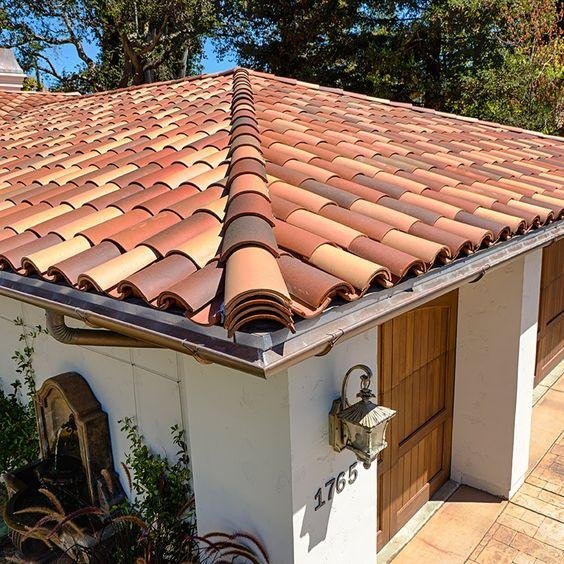
Source: Pinterest
Cedar roof tiles design
Unlike real cedar shakes, which do not hold water, the composite material will not rot, bend, crack, break, or attract fungus. These roof tiles design give the impression of a cedar split shake roof without any drawbacks because they are lightweight and simple to install. Your cedar shake tile roof will look stunning for many years to come due to the vast range of colour choices available.
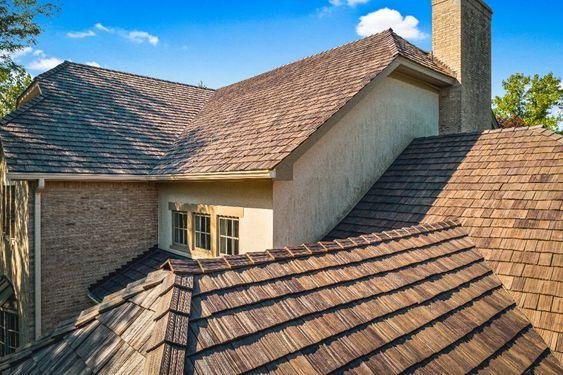
Source: Pinterest
Roof tiles design: Aesthetic and durable options
If you are planning a home renovation project and looking for roof tiles, make sure you select a material that is durable and has long lifespan, to make the most of your investment. Clay tiles have been popular since centuries as they can last up to 100 years. Another choice of durable roof tiles is slate tiles, which can remain up to 150 years. Concrete or metal tiles, on the other hand, can last for up to 50 years.
Stylish roof tiles: Ideas for your home’s exterior
When deiciding on roof tiles for your house, make sure you are clear on the architectural style of your house, the area’s climate, and your personal style. For a high-end exterior look, you can go for slate tiles and customise it by choosing patterns and colours. Consider clay tiles in mediterranean or spanish-style designs. For modern buildings, flat tiles, made of concrete or metal, are desirable.
Roofing materials: Pros and cons of popular tiles
Roof tiles come with their own benefits and drawbacks. Each tiles design must weighed in terms of its durability, aesthetics, and cost to ensure you find the right option for your house.
For example, clay tiles are durable, fire resistant, available in numerous colors and shapes. They can last for several decades. However, they are heavy and need proper support them. They may also be expensive and fragile. On the other hand, concrete tiles can be a good alternative as they offer similar advantages and less expensive too. The downside of concrete tiles is that they are too heavy and require a strong roof structure, and can be prone to cracking.
Metal is another popular material for roof tiles and come with many advantages. They are fire-resistant, energy-efficient, lightweight, durable and can last for up to 50 years. However, they may not be suited for areas prone to frequent rainfall. Besides, they can be expensive to install and susceptible to denting and scratching.
Roof tiles: Tips for choosing the right tiles design for your climate
When choosing roof tiles design for your house, it is essential to consider the climate in your area since certain tile materials are better suited to the specific weather conditions. Follow these tips for choosing roof tiles that are functional and aesthetically appealing:
- Cold climates: Go for tiles that do not crack when exposed to freezing temperatures. Opt for natural stone tiles such as slate and granite. However, make sure they do not have a glossy finish as it can make the surface slippery when wet.
- Hot and humid climates: In hotter climates, roof tiles will be exposed to high temperatures. Hence, some ideal options are porcelain and ceramic, which are known to be durable and moisture resistant. When it comes to colours, go for lighter colors that will keep the interiors cooler.
- Wet climates: In regions that receive frequent rainfall, the roof tiles must be such that it prevents slipping. Choose textured tiles and porcelain tiles.
- Dry climates: In areas exposed to low humidity, choose tiles with a matte finish or natural stone tiles such as limestone or travertine.
- Coastal climates: Tiles in coastal areas must be made of materials that can withstand saltwater and sand. Some examples include porcelain tiles and granite tiles, which are corrosion resistant and easy to clean.
FAQs
What drawbacks do tile roofs have?
Since tile can be very heavy, your home needs to have adequate structural support to sustain a tile roof securely. Roofs made of tiles can be pricey. Roof tiles design made of clay or concrete might cost up to twice as much as asphalt tiles.
Which roof tiles are the most durable?
Slate and clay tiles are the most durable roofing options, although they are more expensive than materials like metal or wood, because they offer class-A fire resistance, withstand wind and rain quite well over time, and are resistant to mildew and fungus. Slate roof tiles design stand out among the available roofing materials as one of the most labour-intensive solutions.
Which roof tiles design are best for hot Indian weather?
The climate of India is tropical. The roofing materials are damaged by heat and UV light. The best roofing materials for Indian homes in hot climates include slate tiles, terracotta tiles, concrete tiles, clay tiles, and metal tiles.
Are roof tiles design fragile?
They are incomparable in terms of design, robustness, and installation requirements. However, hail, severe weather, and ageing over time can cause roof tiles to become damaged, cracked, or even broken.
| Got any questions or point of view on our article? We would love to hear from you. Write to our Editor-in-Chief Jhumur Ghosh at [email protected] |
Housing News Desk is the news desk of leading online real estate portal, Housing.com. Housing News Desk focuses on a variety of topics such as real estate laws, taxes, current news, property trends, home loans, rentals, décor, green homes, home improvement, etc. The main objective of the news desk, is to cover the real estate sector from the perspective of providing information that is useful to the end-user.
Facebook: https://www.facebook.com/housing.com/
Twitter: https://twitter.com/Housing
Email: [email protected]











